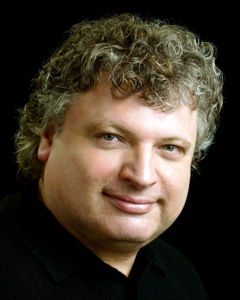Classical Music Review: Masterworks Chorale Sings the American Five
Like music directors of orchestras and chamber groups, choral conductors cannot resist a program with a theme, and for this one, Steven Karidoyanes struck pay dirt.

Masterworks Chorale conductor Steven Karidoyanes ends the season on a high American note.
Reviewed By Susan Miron
The Masterworks Chorale finished their 70th season at their customary home, Sanders Theater, Cambridge, MA on Sunday, May 16. To these ears, it was the chorus’s best concert of this season, which included a concert based on pieces about St. Nicholas and a very good Verdi Requiem in March. The chorus sounded glorious throughout, their balance and diction excellent. Accompanying them were two much-admired, Boston-based pianists, Leslie Amper and Sally Pinkus, who provided the jewels on this concert’s crown.
Like music directors of orchestras and chamber groups, choral conductors cannot resist a program with a theme, and for this one, Steven Karidoyanes struck pay dirt. Mr. Karidoyanes first thought about doing a program of “The American Five”—Barber, Bernstein, Copland, Gershwin, and Ives—16 years ago when conductor Andrew Litton, then working mostly in Europe, complained, tongue-in-cheek, that he was always being asked to conduct one of the American Five. “Isn’t that a great group?” Litton marveled.
Well, yes. But when one thinks of this great group, “The American Five,” either as separate musical entities or as a conglomerate, perhaps the last thing one would think of would be choral music. This well-crafted program, beautifully played and sung, was both the inspired result of Mr. Litton’s gentle sarcasm and some serious musical sleuthing of Mr. Karidoyanes. Even for those who know these composers well, there were many often-unfamiliar songs. For those new to this “great group,” it was a novel yet inspired introduction.
The concert opened with one of this concert’s highlights—Samuel Barber’s gorgeous “Sure on this Shining Night,” which Barber himself loved. As he often does during his concerts, Mr. Karidoyanes then spoke enthusiastically to the audience about the program, something he did before most of the pieces. Luckily for him, the music proved to be as good as he promised. Often one felt transported back 50 years to Bernstein’s own Young Peoples Concerts.
One of the reasons this concert worked so well was its programming, which allowed the two pianists to strut their very fine stuff. Both played a delightful four hand (one piano) arrangement of Barber’s “Waltz” from the Ballet Suite Souvenirs, Op. 28.
Sally Pinkus played Charles Ives’s lyrical “The Alcotts” from Piano Sonata No. 2, Concord Mass., 1840–60, Op. 19 and accompanied the chorus on Ives’s bi-tonal setting of The Sixty-Seventh Psalm. She was terrific, as was Leslie Amper, who served as the chorus’s main accompanist, and who played the famous, much-loved Three Preludes of George Gershwin, first performed by Gershwin at the Roosevelt Hotel in New York in 1926. (Like other composers, Gershwin planned on writing 24 preludes. Only five had public performances; only three were published in 1926).
The big Gershwin discovery was choral music from the film “A Damsel in Distress” (1937), based on a P. G. Wodehouse novel and written by Ira and George Gershwin for their friend Fred Astaire. Two excerpts from this film were “The Jolly Tar and the Milkmaid,” featuring two singers from the chorus (baritone Jer Jurma was excellent) and “Sing of Spring” with words suggestive of chirping birds.
Bernstein’s little-known contribution to this concert was from The Lark, a drama about Joan of Arc: it takes the form of a play, her life, within a play, the trial. It was adapted by Lillian Hellman (from a French version by Jean Anouilh), who simultaneously was working on Candide. Grouped into two texts, French Choruses and Latin Choruses, these often moving songs featured a superb countertenor, Gerrod Pagenkopf.
Copland was represented by music from The Tender Land, an opera originally intended for television, commissioned by Richard Rodgers and Oscar Hammerstein in 1954. The chorus, deftly accompanied by the two pianists, ended with two delightful choral pieces, “The Promise of Living” (reminiscent of Copland’s “Zion’s Walls” from “Old American Songs,”) and the hoedown-like “Stomp Your Foot.” This most unusual program earned and received a long round of applause.
———-
Susan Miron is a harpist, book critic, and essayist.
Tagged: Add new tag, Boston, Classical Music, Masterworks Chorale, Sanders Theater, Stephen Karidoyanes
